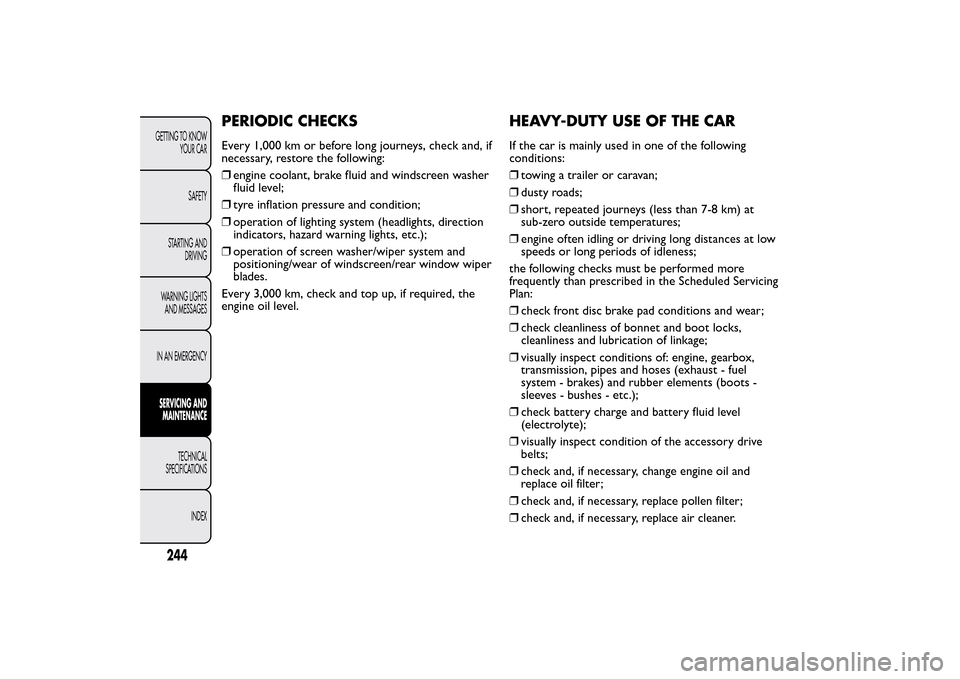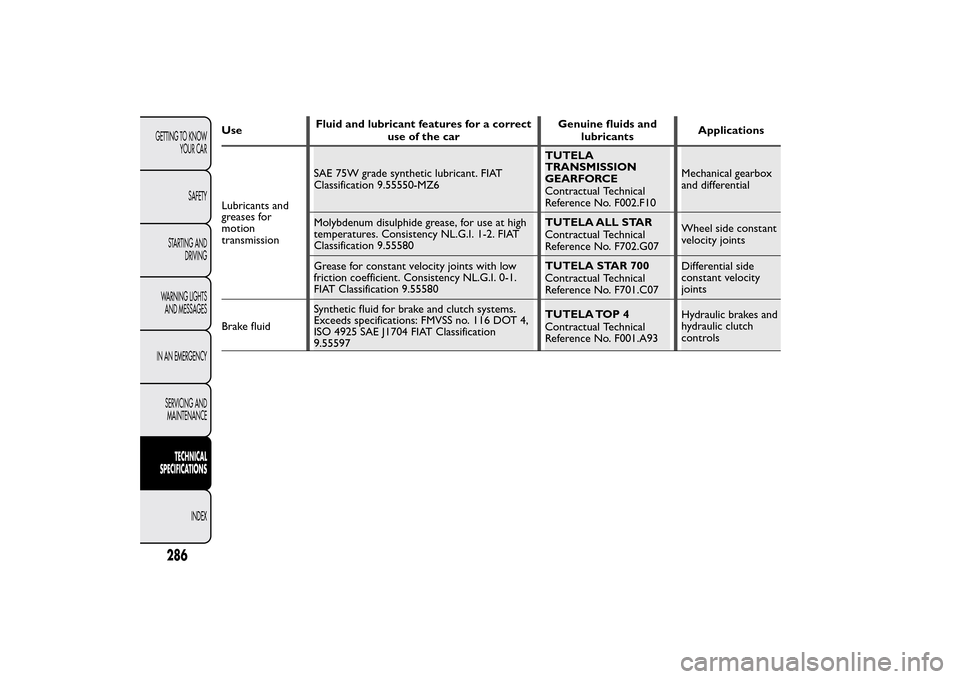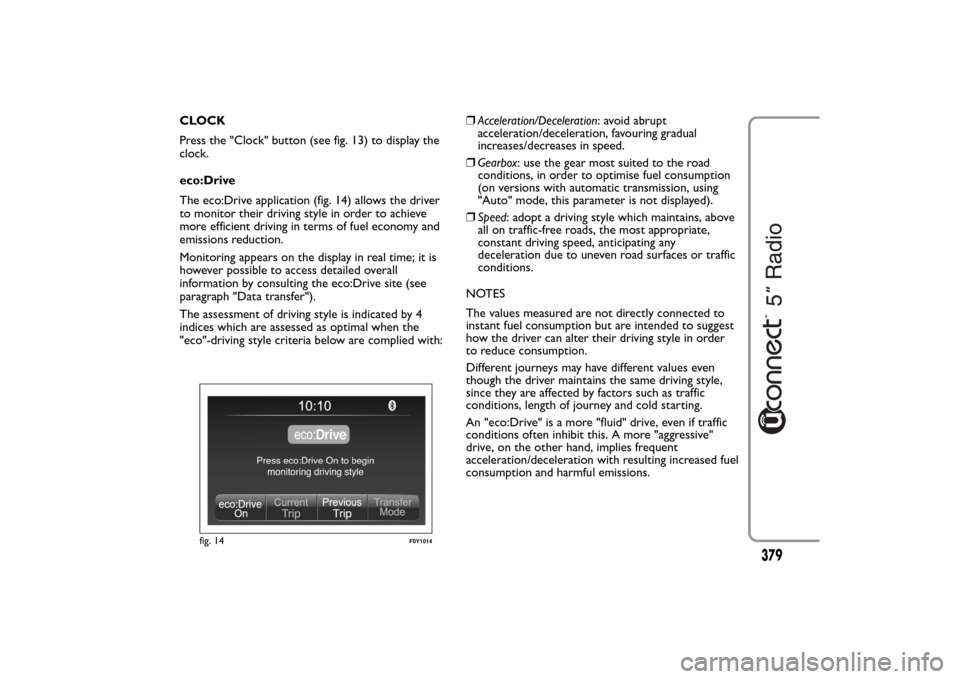Page 248 of 420

PERIODIC CHECKSEvery 1,000 km or before long journeys, check and, if
necessary, restore the following:
❒engine coolant, brake fluid and windscreen washer
fluid level;
❒tyre inflation pressure and condition;
❒operation of lighting system (headlights, direction
indicators, hazard warning lights, etc.);
❒operation of screen washer/wiper system and
positioning/wear of windscreen/rear window wiper
blades.
Every 3,000 km, check and top up, if required, the
engine oil level.
HEAVY-DUTY USE OF THE CARIf the car is mainly used in one of the following
conditions:
❒towing a trailer or caravan;
❒dusty roads;
❒short, repeated journeys (less than 7-8 km) at
sub-zero outside temperatures;
❒engine often idling or driving long distances at low
speeds or long periods of idleness;
the following checks must be performed more
frequently than prescribed in the Scheduled Servicing
Plan:
❒check front disc brake pad conditions and wear;
❒check cleanliness of bonnet and boot locks,
cleanliness and lubrication of linkage;
❒visually inspect conditions of: engine, gearbox,
transmission, pipes and hoses (exhaust - fuel
system - brakes) and rubber elements (boots -
sleeves - bushes - etc.);
❒check battery charge and battery fluid level
(electrolyte);
❒visually inspect condition of the accessory drive
belts;
❒check and, if necessary, change engine oil and
replace oil filter;
❒check and, if necessary, replace pollen filter;
❒check and, if necessary, replace air cleaner.
244GETTING TO KNOW
YOUR CAR
SAFETY
STARTING AND
DRIVING
WARNING LIGHTS
AND MESSAGES
IN AN EMERGENCYSERVICING AND
MAINTENANCE
TECHNICAL
SPECIFICATIONS
INDEX
Page 287 of 420
REFUELLINGPetrol versions0.9 TwinAir Turbo
105 HP1.4 16VPrescribed fuels and
original lubricants
Fuel tank capacity (litres): 50 50
Unleaded petrol not less
than 95 RON (EN 228
specification) including a reserve of
(litres):6÷8 6÷8
Engine cooling system
(litres):5,3 4,550-50 mixture of water and
PARAFLU
UP
(*)
Engine sump (litres): 2.8 2.8SELENIA DIGITEK P.E.
(0.9 TwinAir Turbo 105 HP
version)
SELENIA K P.E.
(1.4 16V version) Engine sump and filter
(litres):3,3 2,95
Gearbox casing/differential
(litres):1,76 1,76TUTELA TRANSMISSION
GEARFORCE
Hydraulic brake circuit (kg): 0,5 0,5 TUTELA TOP 4
Windscreen and rear
window washer fluid
reservoir (litres):2,9 2,9Mixture of water and
TUTELA PROFESSIONAL
SC35(*) For particularly harsh climate conditions, a mixture of 60% PARAFLU
UP
and 40% demineralised water is recommended.
283GETTING TO KNOW
YOUR CAR
SAFETY
STARTING AND
DRIVING
WARNING LIGHTS
AND MESSAGES
IN AN EMERGENCY
SERVICING AND
MAINTENANCETECHNICAL
SPECIFICATIONSINDEX
Page 288 of 420
Diesel versions 1.3 16V MultiJet 1.6 16V MultiJetPrescribed fuels and
original lubricants
Fuel tank (litres): 50 50
Diesel for automotive
engines (EN 590
Specification) including a reserve of
(litres):6÷8 6÷8
Engine cooling system
(litres):5,9 6,35Mixture of distilled water
and 50% PARAFLU
UP
(*)
Engine sump (litres): 3,0 4,3
SELENIA WR P.E.
Engine sump and filter
(litres):3,2 4,75
Gearbox casing/differential
(litres):2,0TUTELA TRANSMISSION
GEARFORCE
Hydraulic brake circuit (kg): 0,5 0,5 TUTELA TOP 4
Windscreen and rear
window washer fluid
reservoir (litres):2,9 2,9Mixture of water and
TUTELA PROFESSIONAL
SC35(*) For particularly harsh climate conditions, a mixture of 60% PARAFLU
UP
and 40% demineralised water is recommended.
284GETTING TO KNOW
YOUR CAR
SAFETY
STARTING AND
DRIVING
WARNING LIGHTS
AND MESSAGES
IN AN EMERGENCY
SERVICING AND
MAINTENANCE
TECHNICAL
SPECIFICATIONS
INDEX
2,0
Page 290 of 420

UseFluid and lubricant features for a correct
use of the carGenuine fluids and
lubricantsApplications
Lubricants and
greases for
motion
transmissionSAE 75W grade synthetic lubricant. FIAT
Classification 9.55550-MZ6TUTELA
TRANSMISSION
GEARFORCE
Contractual Technical
Reference No. F002.F10Mechanical gearbox
and differential
Molybdenum disulphide grease, for use at high
temperatures. Consistency NL.G.I. 1-2. FIAT
Classification 9.55580TUTELA ALL STAR
Contractual Technical
Reference No. F702.G07Wheel side constant
velocity joints
Grease for constant velocity joints with low
friction coefficient. Consistency NL.G.I. 0-1.
FIAT Classification 9.55580TUTELA STAR 700
Contractual Technical
Reference No. F701.C07Differential side
constant velocity
joints
Brake fluidSynthetic fluid for brake and clutch systems.
Exceeds specifications: FMVSS no. 116 DOT 4,
ISO 4925 SAE J1704 FIAT Classification
9.55597TUTELA TOP 4
Contractual Technical
Reference No. F001.A93Hydraulic brakes and
hydraulic clutch
controls
286GETTING TO KNOW
YOUR CAR
SAFETY
STARTING AND
DRIVING
WARNING LIGHTS
AND MESSAGES
IN AN EMERGENCY
SERVICING AND
MAINTENANCE
TECHNICAL
SPECIFICATIONS
INDEX
Page 383 of 420

CLOCK
Press the "Clock" button (see fig. 13) to display the
clock.
eco:Drive
The eco:Drive application (fig. 14) allows the driver
to monitor their driving style in order to achieve
more efficient driving in terms of fuel economy and
emissions reduction.
Monitoring appears on the display in real time; it is
however possible to access detailed overall
information by consulting the eco:Drive site (see
paragraph "Data transfer").
The assessment of driving style is indicated by 4
indices which are assessed as optimal when the
"eco"-driving style criteria below are complied with:❒Acceleration/Deceleration: avoid abrupt
acceleration/deceleration, favouring gradual
increases/decreases in speed.
❒Gearbox: use the gear most suited to the road
conditions, in order to optimise fuel consumption
(on versions with automatic transmission, using
"Auto" mode, this parameter is not displayed).
❒Speed: adopt a driving style which maintains, above
all on traffic-free roads, the most appropriate,
constant driving speed, anticipating any
deceleration due to uneven road surfaces or traffic
conditions.
NOTES
The values measured are not directly connected to
instant fuel consumption but are intended to suggest
how the driver can alter their driving style in order
to reduce consumption.
Different journeys may have different values even
though the driver maintains the same driving style,
since they are affected by factors such as traffic
conditions, length of journey and cold starting.
An "eco:Drive" is a more "fluid" drive, even if traffic
conditions often inhibit this. A more "aggressive"
drive, on the other hand, implies frequent
acceleration/deceleration with resulting increased fuel
consumption and harmful emissions.
fig. 14
F0Y1014
379